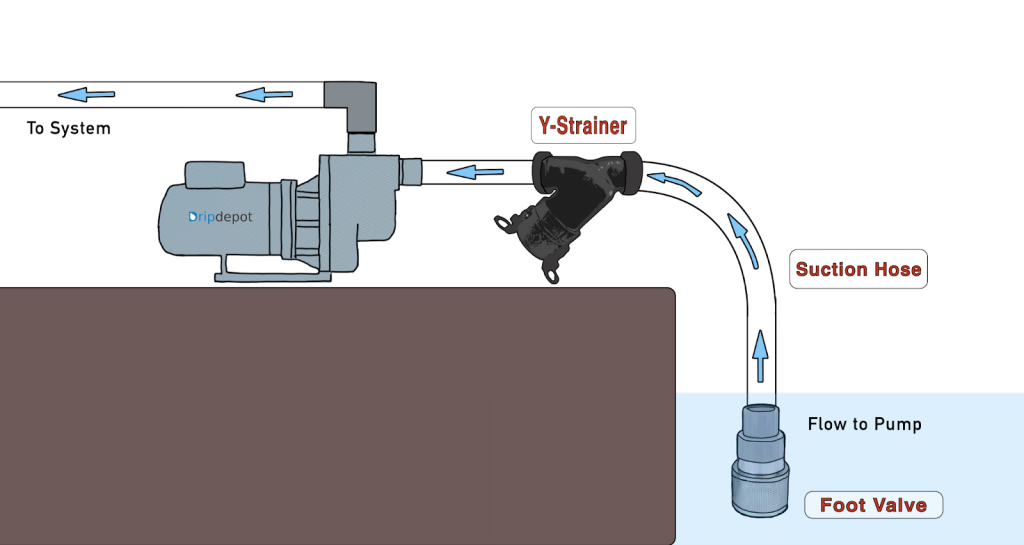Imagine transforming your garden or small farm into a lush, thriving oasis with the simple addition of a small-scale irrigation pump system. You no longer have to worry about inconsistent rainfall or the hassle of manual watering.
With the right guidance, you can create a system that delivers just the right amount of water to your plants, ensuring they grow strong and healthy. Are you ready to take control of your watering needs and boost your garden’s productivity?
In this guide, you’ll discover straightforward steps to build your own irrigation pump system. Whether you’re a seasoned gardener or a beginner, these tips are designed with you in mind. So, if you’re eager to learn how to make your gardening more efficient and effective, keep reading. Your plants—and your future self—will thank you.

Choosing The Right Pump
Choosing the right pump for a small-scale irrigation system is essential. The pump determines the efficiency of water distribution. It affects the overall health of your plants. A well-chosen pump saves time and energy. It ensures your crops thrive.
Understanding Pump Types
There are several types of pumps available. Centrifugal pumps are popular. They are easy to maintain. They suit small-scale irrigation well. Submersible pumps are another option. They work underwater. They are often quieter. Each pump type has unique features.
Considering Pump Capacity
Pump capacity is crucial. It refers to the amount of water a pump can move. Calculate your water needs first. Consider the size of your land. The pump should meet these needs efficiently. A pump with too high capacity wastes energy. A pump with too low capacity struggles to supply enough water.
Evaluating Energy Efficiency
Energy efficiency is important for cost savings. Look for pumps with energy-efficient ratings. These pumps consume less power. They help lower electricity bills. Efficient pumps also have less impact on the environment. They support sustainable irrigation practices.
Assessing Durability And Maintenance
Durability is key for long-term use. Choose pumps made from quality materials. Stainless steel and cast iron are good options. Regular maintenance keeps pumps in top condition. Check for easy access to parts. This simplifies repairs and servicing.
Setting Up The Water Source
Setting up the water source is crucial for your irrigation system. The process requires careful consideration of several factors. You need a reliable and clean water supply to ensure efficient irrigation. This section will guide you through the necessary steps.
Choosing A Suitable Location
Pick a location near your plants. It reduces the need for long pipes. A closer source saves energy and time. Ensure the area is free from debris. This prevents blockages in the pump system.
Determining The Water Quality
Check the water quality before use. Test for contaminants and pH levels. Clean water is essential for healthy plants. Poor water quality can harm crops.
Calculating The Water Volume Needed
Estimate the water volume your crops need. Consider the crop type and growth stage. This helps in selecting the right pump size. It ensures efficient water delivery to your plants.
Securing The Water Source
Make sure the water source is secure. Use a cover to keep it clean. Protect it from animals and debris. A secure source maintains water quality.
Installing A Filtration System
Install a filtration system to remove impurities. It prolongs the life of your pump. Filters prevent clogging and ensure smooth operation. Regular maintenance is necessary for optimal performance.
Installing The Piping System
Building a small-scale irrigation pump system requires careful planning and execution. Installing the piping system is a crucial step in this process. Proper installation ensures efficient water flow. It also helps prevent leaks and maintain system longevity. Follow these steps to install your piping system effectively.
Choosing The Right Pipes
Select pipes suitable for your irrigation needs. Consider pipe material and diameter. PVC pipes are a common choice. They are durable and affordable. Ensure the pipes can handle the water pressure. This prevents future problems.
Mapping Out The Layout
Plan your piping layout before installation. Draw a simple map of your garden. Mark the areas needing irrigation. This helps in calculating the needed pipe length. It also ensures efficient water distribution.
Cutting And Connecting The Pipes
Measure and cut pipes to fit your layout. Use a pipe cutter for clean cuts. Connect pipes using appropriate fittings. Ensure each connection is secure. Leaks can occur if connections are loose.
Securing The Pipes
Secure pipes to prevent movement. Use pipe clamps or stakes. This prevents damage from ground movement. It also keeps the pipes in place during water flow.
Testing The System
Test the system after installation. Turn on the water pump. Check for leaks and ensure smooth water flow. Make adjustments as needed. A well-installed system saves time and water.

Maintaining The Irrigation System
Proper maintenance ensures your irrigation system runs efficiently. Regular care helps prevent breakdowns and costly repairs. It extends the lifespan of the system, ensuring consistent water supply to your plants.
Checking For Leaks
Leaks can waste water and increase costs. Inspect hoses and connectors for signs of wear. Tighten loose connections to prevent water loss. Replace damaged parts promptly to maintain efficiency.
Cleaning The Filters
Filters prevent debris from clogging the pump. Check filters regularly to ensure they are clean. Remove any dirt or blockages that may restrict water flow. Clean filters improve water quality and system performance.
Inspecting The Pump
The pump is the heart of the irrigation system. Regularly inspect the pump for any unusual noises or vibrations. Ensure all moving parts are in good condition. Lubricate as needed to reduce wear and tear.
Monitoring Water Pressure
Water pressure impacts system effectiveness. Use a gauge to monitor pressure levels. Adjust the pump or valves if pressure is too high or low. Consistent pressure ensures even water distribution.
Scheduling Regular Maintenance
Create a maintenance schedule to keep track of checks and repairs. Regular maintenance prevents major issues and helps you catch problems early. A well-maintained system supports healthy plant growth.

Conclusion
Creating your own small-scale irrigation pump system is achievable. You just need the right tools and steps. Start small. Learn from each experience. This system conserves water and supports plant growth. It benefits both the environment and your garden. Remember to check and maintain your system regularly.
Proper care ensures lasting performance. Building this system helps you become more self-sufficient. You also reduce water waste. Share your results and inspire others. Let your garden thrive with efficient irrigation. Happy gardening!


